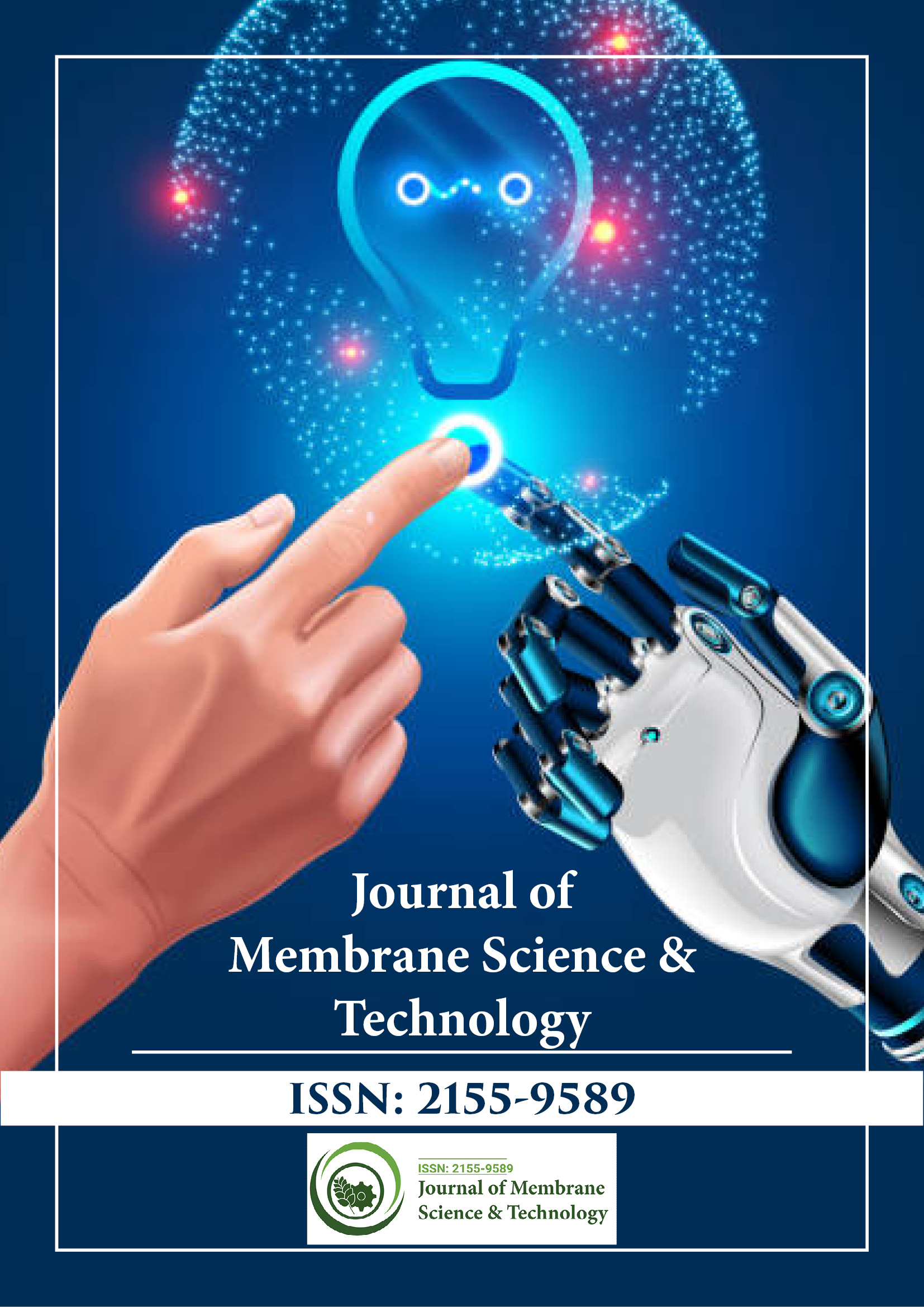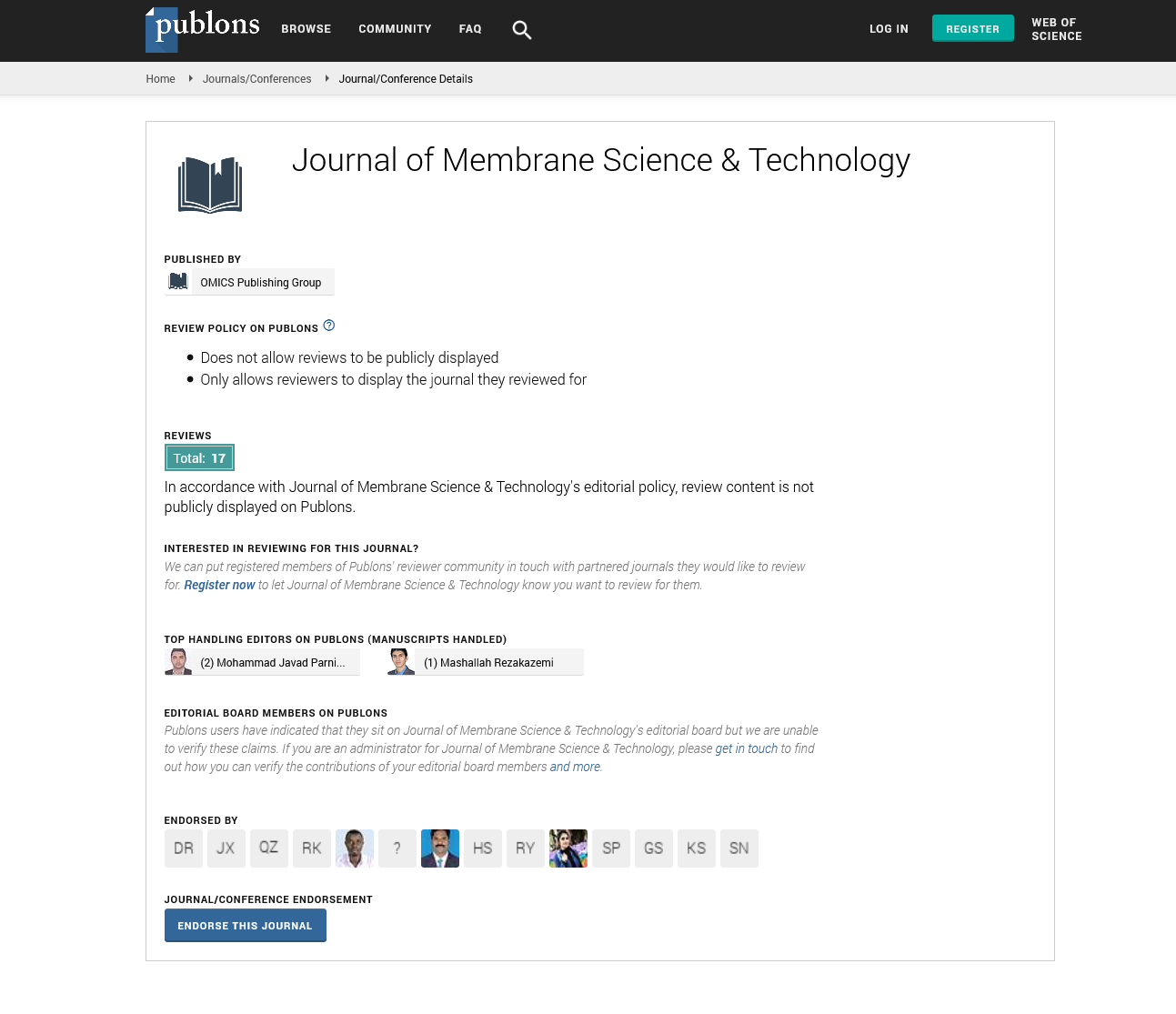Indexed In
- Open J Gate
- Genamics JournalSeek
- Ulrich's Periodicals Directory
- RefSeek
- Directory of Research Journal Indexing (DRJI)
- Hamdard University
- EBSCO A-Z
- OCLC- WorldCat
- Proquest Summons
- Scholarsteer
- Publons
- Geneva Foundation for Medical Education and Research
- Euro Pub
- Google Scholar
Useful Links
Share This Page
Journal Flyer

Open Access Journals
- Agri and Aquaculture
- Biochemistry
- Bioinformatics & Systems Biology
- Business & Management
- Chemistry
- Clinical Sciences
- Engineering
- Food & Nutrition
- General Science
- Genetics & Molecular Biology
- Immunology & Microbiology
- Medical Sciences
- Neuroscience & Psychology
- Nursing & Health Care
- Pharmaceutical Sciences
Commentary - (2025) Volume 15, Issue 2
Understanding the Formation and Structure of Membranes in Advanced Applications
Masoud Rahbari*Received: 30-Apr-2025, Manuscript No. JMST-25-29438; Editor assigned: 02-May-2025, Pre QC No. JMST-25-29438; Reviewed: 16-May-2025, QC No. JMST-25-29438; Revised: 23-May-2025, Manuscript No. JMST-25-29438; Published: 30-May-2025, DOI: 10.35248/2155-9589.25.15.420
Description
Membrane formation and structure are central to the function and performance of membranes across various scientific and industrial applications. Membranes serve as selective barriers, allowing certain molecules or ions to pass through while restricting others. The effectiveness of this selective transport largely depends on the membrane’s internal structure, which in turn is dictated by the method of formation. Whether used in water treatment, gas separation, biomedical devices, or chemical processing, the structural properties of membranes such as pore size, porosity, surface roughness and thickness are critical for determining permeability, selectivity and mechanical stability. Membranes can be broadly classified into dense and porous types, each with distinct formation processes and structural characteristics. Dense membranes are typically used in applications requiring molecular-level separation, such as reverse osmosis or gas separation. These membranes are formed to have no visible pores and their transport mechanism is based on diffusion through a polymer matrix. In contrast, porous membranes are designed with interconnected voids or channels that allow the passage of fluids or particles, used commonly in microfiltration and ultrafiltration processes.
One of the most widely used techniques for membrane fabrication is phase inversion. This method involves transforming a polymer solution into a solid membrane through a change in conditions such as temperature, solvent evaporation, or immersion in a nonsolvent bath. The most common version, known as immersion precipitation, involves casting a polymer solution onto a surface and immersing it in a nonsolvent, typically water. The solvent and nonsolvent exchange causes the polymer to precipitate, forming a solid structure with a dense skin layer and a porous substructure. The morphology of the resulting membrane is highly sensitive to factors such as polymer concentration, solvent-nonsolvent miscibility, temperature and additives used in the casting solution.
Another important method is interfacial polymerization, particularly for the creation of thin-film composite membranes. In this technique, two monomers dissolved in immiscible phases react at the interface to form a thin, dense selective layer on top of a porous support. This process is commonly used to fabricate membranes for Nano filtration and reverse osmosis due to its ability to produce highly selective and defect-free layers. The underlying support layer provides mechanical strength while the top layer performs the selective separation.
Electrospinning is another technique that allows the fabrication of membranes with Nano fibrous structures. In electrospinning, a high-voltage electric field is applied to a polymer solution or melt, drawing thin fibers that are collected on a substrate to form a nonwoven mat. The resulting membrane typically has high porosity, interconnected pores and large surface area, making it suitable for applications such as air filtration, tissue engineering and drug delivery.
Membrane structure also varies significantly depending on the material used. Polymeric membranes, such as those made from Polysulfone, Polyvinylidene Fluoride (PVDF), or cellulose acetate, are widely used due to their flexibility, ease of processing and relatively low cost. These membranes can be tailored to exhibit asymmetric structures, where a dense top layer is supported by a porous sublayer, providing a good balance between selectivity and permeability. Inorganic membranes made from ceramics, metals, or silica typically possess a more rigid and uniform structure, offering superior thermal and chemical stability but at a higher production cost.
The internal structure of membranes is often characterized using techniques such as Scanning Electron Microscopy (SEM), Atomic Force Microscopy (AFM) and porosimetry. These tools provide insights into pore size distribution, surface morphology and layer thickness critical parameters that influence transport properties. Additionally, techniques like X-Ray Diffraction (XRD) and Fourier-Transform Infrared (FTIR) are used to understand the chemical structure and interactions within the membrane matrix.
Membrane structure is not static; it can evolve over time during use due to compaction, fouling, or chemical degradation. Compaction occurs when the membrane is exposed to high pressures, leading to pore collapse and reduced permeability. Fouling, which involves the accumulation of particles, microorganisms, or organic substances on the membrane surface, alters both structure and performance. To mitigate these issues, surface modifications such as coating with hydrophilic materials, grafting functional groups, or embedding nanoparticles are employed. These modifications can reduce fouling potential and enhance the membrane’s operational lifespan.
Advancements in computational modeling have also contributed to a deeper understanding of membrane structure and formation. Molecular dynamics simulations and phase field models are increasingly used to predict how different conditions and materials affect membrane morphology. These tools can help optimize fabrication parameters, reducing experimental time and cost.
Conclusion
Ultimately, the formation and structure of membranes determine their suitability for specific separation tasks. A well- designed membrane must possess a structure that supports high selectivity without compromising permeability or mechanical integrity. As demand grows for more efficient, durable and application-specific membranes, continued research into formation techniques and structural characterization remains essential. With interdisciplinary efforts spanning materials science, chemical engineering and nanotechnology, future membranes will increasingly be designed with precision at the molecular level to meet the evolving needs of society.
Citation: Rahbari M (2025) Understanding the Formation and Structure of Membranes in Advanced Applications. J Membr Sci Technol. 15:420.
Copyright: © 2025 Rahbari M. This is an open-access article distributed under the terms of the Creative Commons Attribution License, which permits unrestricted use, distribution and reproduction in any medium, provided the original author and source are credited.

